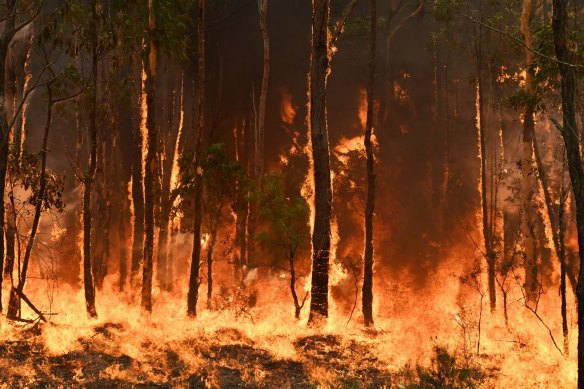Strategizing for Safety: Establishing an Effective Bushfire Management Plan
Strategizing for Safety: Establishing an Effective Bushfire Management Plan
Blog Article
Necessary Tips for Bushfire Administration to Ensure Fire Protection
/cdn.vox-cdn.com/uploads/chorus_image/image/66063681/GettyImages_1197451354.0.jpg)
Comprehending Bushfire Danger Degrees
Comprehending the differing levels of bushfire danger is vital for reliable planning and preparation in mitigating prospective dangers to lives and residential or commercial properties. Bushfire threat degrees are typically categorized based upon elements such as weather, fuel schedule, topography, and historical fire actions. By comprehending these risk individuals, degrees and neighborhoods can proactively apply methods to reduce susceptability and improve durability when faced with potential bushfire occasions.
The very first degree of bushfire risk is reduced risk, where the chance of a bushfire happening and causing considerable harm is minimal. High-risk levels represent a considerable danger, with conditions conducive to fast fire spread and severe fire habits.
Comprehending these bushfire threat levels allows stakeholders to customize their preparedness and reaction activities accordingly, guaranteeing a proactive and efficient technique to bushfire administration.
Creating a Defensible Space
Effective bushfire management begins with establishing a defensible area around homes to improve defense against possible fire risks. A defensible room is a barrier area that creates a barrier between a framework and the surrounding flammable greenery. This area functions as an important line of protection, giving firemens a secure area to operate and aiding to decrease the threat of a fire infecting the residential property.
When creating a defensible area, it is vital to consider the format of the residential property and the bordering landscape. Cleaning greenery, specifically very combustible plants, within a certain distance of the residential property can help avoid the fast spread of fires. Furthermore, preserving a well-irrigated zone around the property can additionally boost its defensibility.
Routine upkeep of the defensible area is important to ensure its effectiveness. This includes trimming looming branches, getting rid of dead vegetation, and keeping the area devoid of particles. By spending time and effort into developing and keeping a defensible room, homeowner can dramatically boost their chances of shielding their homes and possessions throughout a bushfire.
Executing Fireproof Landscaping
When designing landscapes to mitigate the threat of bushfires, integrating fireproof components is vital for improving property security and decreasing fire risks. Select plants with high dampness web content, low oil web content, and minimal dead plant life to minimize the threat of fire spread.

Producing an Emergency Emptying Plan
Developing a comprehensive emergency discharge strategy is vital for making sure the security and well-being of individuals during potential bushfire incidents (Bushfire Risk). An efficient discharge strategy need to detail clear treatments to comply with in the event of a bushfire risk, consisting of marked evacuation paths, setting up factors, and communication procedures
To begin producing an emergency emptying strategy, it is vital to assess the specific threats and susceptabilities of your place. Recognize multiple emptying routes that result in secure locations away from the fire, considering variables such as surface, roadway availability, and potential threats. Establish interaction networks to alert locals of an upcoming evacuation, utilizing methods such as sirens, text signals, or door-to-door notifications.
Routinely review and practice the emptying plan with all homeowners or area members to make certain everyone recognizes read the full info here their responsibilities and functions. Conduct drills to examine the efficiency of the plan and make any type of required changes. By having a well-prepared evacuation strategy in position, you can boost the chances of a organized and risk-free discharge throughout a bushfire emergency situation.
Keeping Fire Safety Devices
After establishing a detailed emergency discharge prepare for bushfire incidents, it is important to focus on the regular upkeep of fire security equipment to make this content certain optimal performance and preparedness. Normal maintenance of fire security devices such as fire extinguishers, smoke detectors, smoke alarm, and sprinkler systems is vital in protecting lives and building throughout a bushfire. Performing routine evaluations, screening, and maintenance of these gadgets by certified specialists is vital to assure they remain in working order when needed.
Fire extinguishers should be examined consistently for stress degrees, noticeable damages, and appropriate functionality. By diligently keeping fire security tools, people can improve their readiness and feedback capacities in the occasion of a bushfire.
Conclusion
To conclude, reliable bushfire management includes comprehending danger levels, producing defensible rooms, carrying out fireproof landscaping, developing evacuation strategies, and maintaining fire security equipment. By complying with these important ideas, individuals can make sure much better fire protection and security for their residential or commercial properties and neighborhoods. It is necessary to prioritize proactive measures to minimize the threats related to bushfires and to be prepared for emergencies.
By comprehending the nuances of bushfire threat levels, developing defensible rooms, carrying out fireproof landscape design, developing extensive evacuation plans, and ensuring the maintenance of fire security devices, neighborhoods and individuals can significantly boost their strength versus the ravages of wildfires - BAL Report. These suggestions are not only important for securing recommended you read against immediate fire threats yet likewise for fostering lasting fire defense strategies that can make a considerable distinction in the face of rising bushfire dangers
Risky levels signify a considerable danger, with conditions helpful to rapid fire spread and extreme fire actions. Routine maintenance of fire safety devices such as fire extinguishers, smoke detectors, fire alarms, and lawn sprinkler systems is important in protecting lives and home during a bushfire.In final thought, efficient bushfire management involves recognizing danger degrees, producing defensible spaces, implementing fire-resistant landscaping, developing discharge plans, and maintaining fire safety devices.
Report this page